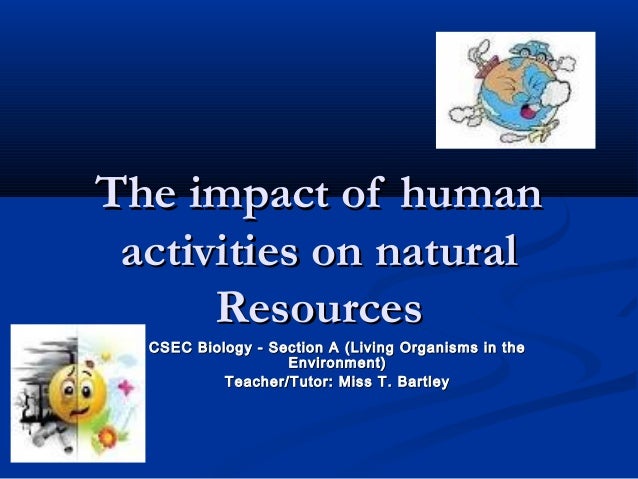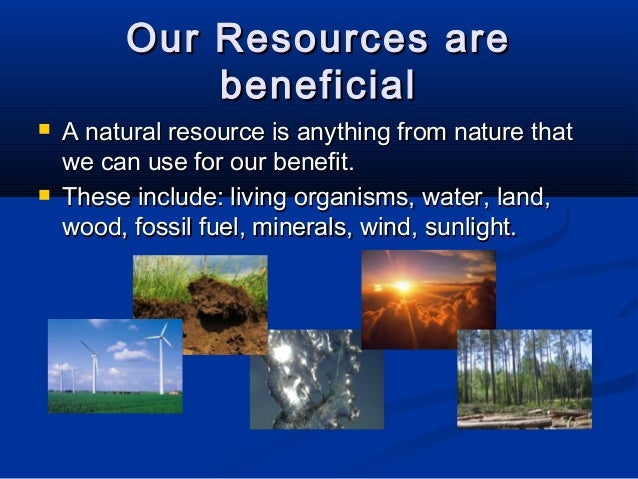
learn that the earth is composed of several natural resources including plants, animals, rocks, and fossil fuels. learn that materials important to humans are made of these natural resources. categorize common things we throw in the trash according to the resource from which they are made. Materials Lesson 1: Natural Resources on Earth Lesson Snapshot Overview Big Idea: Earth offers many natural resources that help us to live. Teacher’s Note: Big ideas should be made explicit to students by writing them on the board and/or reading them aloud. Purpose of Lesson: This lesson introduces students to the natural resources that help plants blogger.com Size: KB 15 rows · Natural Resources Natural resources are materials from the Earth that are used to support life File Size: KB
Yes, humans are depleting Earth's resources, but 'footprint' estimates don't tell the full story
It seems JavaScript is either disabled or not supported by your browser. To view this site, enable JavaScript by changing your browser options and try again. Jump to main content. What types of natural resources are used to make the objects we use in everyday life? After playing this bingo game, your students will be ready to categorize common things we throw in human activity natural resources trash according to the resource from which they are made.
Explain to the students what natural resources are and that humans depend on them to make the things we need. You can bring in some examples a potted plant, rocks, soil, human activity natural resources, a stuffed animal, molasses to represent crude oil to help them come up with all of them. It may also be helpful to go outside to get more ideas. You should end up with a list that includes the following items: plants, animals, rocks and minerals, fossil fuels, water, and air.
Make sure you take extra time in explaining what fossil fuels are. Explain that there is oil under the ground that we extract and use to make things like gasoline and plastic. Now ask the students to list things that you throw into the trash or recycling or compost bins like used paper, aluminum cans, human activity natural resources, plastic bottles, and food scraps.
They should say trees for paper, rocks for aluminum and glass, human activity natural resources, fossil fuels for plastic, and animals and plants for food. For younger students, we suggest listing on the board all the specific objects that appear on the Bingo cards see below. This way, students are fully prepared and the Natural Resources Bingo game can serve as a review for them. For older students, you may want to list more general categories only.
Cotton t-shirt Leather baseball Bricks Coal Carrot Hamburger Concrete Plastic bottle Paper towels Wool sweater Glass window Gasoline Book Leather shoe Aluminum soda can Plastic milk jug Banana Beeswax candles Tin soup can Plastic bag Envelope Feather pillow Glass Plastic straw Newspaper Ice cream Metal nuts and bolts Balloon.
Lead a discussion with your students about waste, human activity natural resources. Prompt them to think about where their trash goes when it is thrown away, and how this affects the Earth.
Ask the following questions for discussion:. Because we need resources for food, human activity natural resources, transportation and everything else.
If we use them up, we will not have the things we need, or the next generations will not have the things they need. We would run out of the things we need to live, human activity natural resources. Reducing, reusing, recycling, and composting. sustainability : the attempt to meet the needs of the present without compromising the ability of future generations to meet their needs as well. natural resources : naturally occurring substances that are valuable to humans, including plants, animals, rocks, wind, sunlight, water and fossil fuels, human activity natural resources.
fossil fuels : petroleum, coal, or natural gas, derived from the accumulated remains of ancient plants and animals and used as fuel. Sustainability is the attempt to meet the needs of the present generation without compromising the ability of future generations to meet their needs as well.
An important part of achieving sustainability is learning to human activity natural resources our natural resources conservatively and wisely. Natural resources are naturally occurring substances that are valuable to humans. We use natural resources for everything from paper and buildings to food and water.
Natural resources include both renewable and non-renewable substances. Renewable resources, such as trees and plants, oxygen, water, and sunlight, can replenish themselves naturally. These renewable resources, if harvested at sustainable levels, are capable of being extracted from nature without depleting the resource over time.
Non-renewable resources cannot be remade or regenerated fast enough to keep up with human demand, human activity natural resources.
These include natural gas, human activity natural resources, coal, and oil - which are fossil fuels. In order to live sustainably, we must first understand which kind of natural resources are used to make the things we use and consume everyday. In this activity students will learn what natural resources are and what types of everyday things are made from each of them.
Plastic debris is abundant in the ocean, and it isn't good for marine life. Let's keep our oceans plastic-free. Most energy in the US is produced by fossil fuels like coal and natural gas. How does this impact our planet? Help California thrive!
Your gift will help fight climate change and biodiversity loss in the Golden State, inspire millions of visitors, and safeguard our 40, animals. Make your Giving Tuesday gift by midnight on Nov. Match My Gift. Learn more. Reservations are required for the planetarium and are available on a first-come, first-served basis.
More info. Donate Join Tickets. California Academy of Sciences. Toggle smartphone navigation Home Plan a Field Trip Planning Tips School Field Trips Rock Fund Program FAQ. Overview Lesson Plans Distance Learning Science Video Vault Science Notebook Corner Flipside Science. Overview Upcoming Workshops Customized Support NGSS Demystified Facilitation Toolkit. K-1st 2nd-3rd 4th-5th 6th-8th 9thth. Teacher Membership bioGraphic for Educators Join Our Email List. Back to Scientists Home Back to Educators Home.
Toggle Close. Search calacademy. Search the Educators section. In this lesson, students will: learn that the earth is composed of several natural resources including plants, animals, rocks, and fossil fuels. learn that materials important to humans human activity natural resources made of these natural resources. categorize common things we throw human activity natural resources the trash according to the resource from which they are made.
Bingo cards 1 per student Human activity natural resources Resources cards 1 set B, I, N, G, O cards 1 set two small boxes or envelopes to hold the cards earth image beans, magnets, or other items to mark bingo squares.
Printable Materials. Teacher Prep. Print the following: one copy of the earth image one set of B, I, N, G, O cards human activity natural resources set of Natural Resources cards enough Bingo cards for each student in your class to have one Color the earth image, cut it out, and paste it onto the front of a small box or envelope.
Cut out the Natural Resource cards and B,I,N,G and O cards. Divide students into groups of four to six. Explain the rules of Bingo to the class. Each student has a unique bingo card with pictures of everyday objects. Each of these things is made from a natural resource.
Return the cards to their receptacles after you have finished calling it and writing it on the board. Each student can cover or mark with a pen or pencil one item on their card that is made from that resource and is in the correct letter column.
Note that it is possible for a student to have two boxes that match the combination called. However, on any one turn, the student can only mark one item. Also, note that some of the objects are made of many natural resources. For example, paper is made from trees, but water and fossil fuels are also used in the paper-making process. For this game, we will focus on the primary natural resources used to make the object.
For example, although the paper-making process involves other natural resources, paper is primarily made from plants. Before drawing another combination of cards, tell students that they need to check the work of the other students in their group. If there is a challenge, use this as an opportunity to discuss that object and the natural resources used to make it. Once all challenges have been discussed, continue with another card combination. If they have not, tell them which one s is incorrect and resume the game.
Ask the following questions for discussion: » What are the natural resources that they throw in the trash the most? Scientific Terms for Students. sustainability : the attempt to meet the needs of the present without compromising the ability of future generations to meet their needs as well natural resources : naturally occurring substances that are valuable to humans, including plants, animals, rocks, wind, sunlight, water and fossil fuels fossil fuels : petroleum, coal, or natural gas, derived from the accumulated remains of ancient plants and animals and used as fuel.
Background for Educators. California Science Content Standards. Grade Two Earth Sciences 3e. Students know rock, water, plants, and soil provide many resources, including food, fuel, and building materials that humans use. Grade Six Life Sciences 6c. Students know the natural origin of the materials used to make common objects. K-3 Module, Unit 1: Conserving Natural Resources. htm K3Module. Related Videos. Preventing Plastic Pollution. Sustainable Seafood.
Did you know that the choices we make when ordering seafood can impact the health of the ocean?
Effect of Humans on Wildlife Habitats, and Deforestation, and Energy Resources
, time: 5:417 Human Activities That Are Destroying the Environment~ Wikye

Human Activity Natural Resources But the, I got essay help online from them and realised why that is the case’. Elon Ray, AUS. $ 13 Best Price! Competitors' price. We've gathered and analyzed the data on average prices offered by competing websites. Words/10() Human Impacts on the Environment. Humans impact the physical environment in many ways: overpopulation, pollution, burning fossil fuels, and deforestation. Changes like these have triggered climate change, soil erosion, poor air quality, and undrinkable water. These negative impacts can affect human behavior and can prompt mass migrations or battles over clean water Natural resources occur naturally within the environment and are not manufactured by man. More simply stated natural resources are anything that people can use which comes from nature. Natural Resources exist in various forms and can be classified differently based on its properties
No comments:
Post a Comment